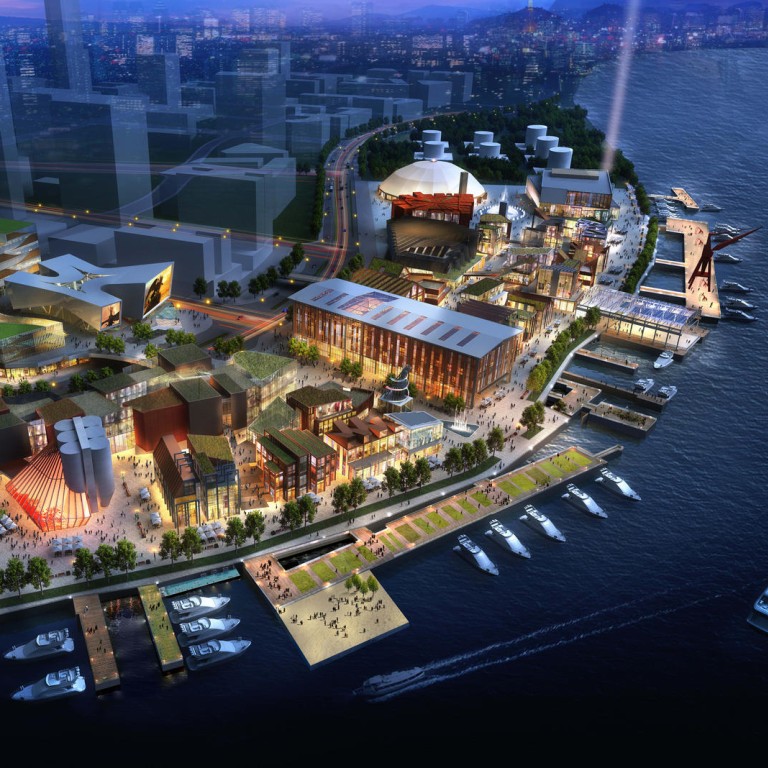
New | Shanghai dreams of its own Broadway with project backed by Allan Zeman
Lan Kwai Fong's Allan Zeman spearheads the 15 billion yuan development billed as a world-class urban centre for entertainment and arts
If Allan Zeman can transform an old market district of Hong Kong into one of the hippest (and most bankable) entertainment brands in Asia, why can't he take Broadway to Shanghai? Or, for that matter, a good slug of Hollywood?
The so-called "father" of Lan Kwai Fong is doing just that, spearheading the Shanghai DreamCenter, a 15 billion yuan "lifestyle destination" on the West Bund - a concept imagined by United States film studio DreamWorks Animation and jointly backed by China Media Capital - a state-backed investment fund - and China Development Bank.
Zeman is the founder of Lan Kwai Fong Group, a multi-faceted company based on restaurants, bars and property interests in Hong Kong, mainland China and overseas, whose daily operations are now overseen by his son, Jonathan Zeman, as chief executive.
The group has already taken its brand to mainland China, opening LKF Chengdu in December 2010, and the upcoming LKF Haikou at Mission Hills Golf Resort, Hainan Island, due to open in the fourth quarter, and LKF Wuxi, slated for opening in the middle of next year. But the Shanghai DreamCenter will be its most ambitious yet.
Jeffrey Katzenberg, the chief executive of DreamWorks, has boasted that this would become the world's third great urban centre of entertainment and arts, "alongside New York's Broadway, and London's West End".

A "Dream Avenue" theatre district will anchor the 15-hectare development fronting the Huangpu River, near the 2010 Shanghai World Expo site, which in addition to performance venues of both grand and intimate scale will incorporate a nine-screen IMAX theatre - the biggest screen measuring 27 metres by 15 metres - to host international film festivals and red-carpet events.
There will be a full complement of bars and restaurants, various arts and cultural spaces, shops and offices, including the headquarters of Oriental DreamWorks, a major animation studio working on the production of Kung Fu Panda 3.
A Lego discovery centre is on the wish list.
The project is slated for completion in 2017.
Architectural firms from around the world have been drawn in to make it happen, including KPF of New York, 3XN and SHL from Denmark, and Hong Kong's Oval Partnership.
The site has a number of cultural buildings the government wanted retained, notably a cement factory from the 1930s which produced construction materials for many significant buildings on the Bund, says Bill Lykouras, an Australian architect who is design director at Lan Kwai Fong Group.

That will include repurposing the cement factory into the Dream Dome, a 1,800-seat Broadway-style theatre set beneath the original 80-diameter dome.
In the tone of complexes such as 798 in Beijing, an art district repurposed from old electronics factories, and Origin Architect's conversion of an old printing factory into 77 Theatre, it will also involve converting an old warehouse into a hub of galleries, design companies and artists' studios.
Concrete silos will be adaptively reused for food and beverage and retail outlets; the former stone and cement storage warehouse converted for exhibitions, retail and dining; and the old riverboat maintenance shed revitalised into an arts and entertainment venue where, inspired by the pavilion at London's Serpentine Galleries, a new installation will be commissioned every year.
Existing piers will also be retained as part of a waterfront promenade akin to Sydney's Darling Harbour.
Collectively, these heritage buildings account for only about 30,000 sq metres of the development's total footprint of 500,000 sq metres, but they are reflective of the local government's new-found appreciation for its cultural past, swathes of which had been razed over decades in the race to build anew.
Within this cultural overlay, the right tenant mix is needed to make the project commercially viable. As Bill Lykouras points out, theatres are expensive to build and run, and even the food and beverage business is not as profitable as the cream that comes from high-end retail.

Yet the Shanghai DreamCenter will not be just another commercial mall: its overall vibe will emulate the unique urban experiences of, say, the intimate central business district laneways of Melbourne, Australia, and Tianzifang in Shanghai's Old French Quarter, he said.
Another challenge is integrating the three sites the project will encompass with six neighbours, to make up the parcel of nine sites the Shanghai government wants to link up.
The unifying element will be in the landscaping, designed by Aspect Studios from Sydney as a tree-lined boulevard on platform level. In the grand plan, this open space functions as a public lounge where people can wine, dine, watch events and appreciate art, all within a pedestrian-friendly green environment elevated above the bustle of Shanghai.

